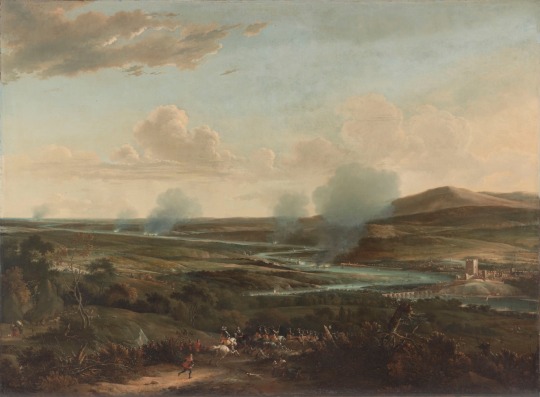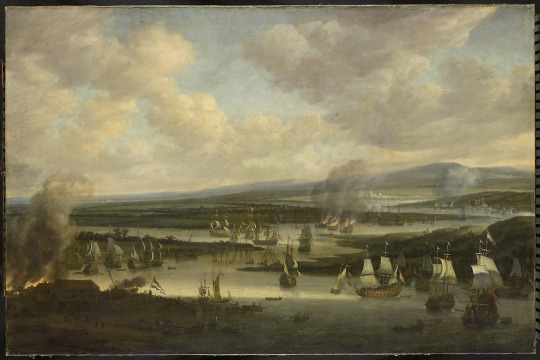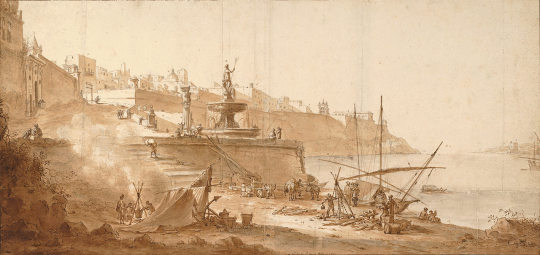#Willem Schellinks
Explore tagged Tumblr posts
Text

Willem Schellinks, City Walls in Winter, ca. 1650-70, oil on canvas, 74 x 105 cm, Rijksmuseum, Amsterdam
#willem schellinks#17th century#1650s#1660s#baroque#dutch baroque#winter#winter landscape#landscape painting#snow
8 notes
·
View notes
Text

The Raid on the Medway, 1667 by Willem Schellinks
#willem schellinks#art#raid#river medway#michiel de ruyter#england#english#dutch#navy#naval battle#age of sail#netherlands#dutch republic#kingdom of england#history#europe#landscape#musketeers#musketeer#second anglo dutch war#chatham#kent#rochester#warships#ships#fire#smoke#castle#fortress#upnor castle
28 notes
·
View notes
Text

City Walls in Winter by Willem Schellinks, 1650-1670.
#classic art#painting#willem schellinks#dutch artist#17th century#baroque#landscape#buildings#staffage#winter#ice
29 notes
·
View notes
Photo


City Walls in Winter (and detail) by Willem Schellinks
Dutch, c. 1650-1670
oil on canvas
Rijksmuseum
#winter#cityscape#genre scene#genre painting#Willem Schellinks#Dutch#art#painting#Dutch Golden Age#baroque#ice#canal#art detail#detail#Rijksmuseum
177 notes
·
View notes
Text

Willem Schellinks, Study of a Man Holding a Basket, 1650-1660 x
0 notes
Text



Willem Schellinks, 1650-1670.
Willem Schellinks (1623-1678) était un peintre, dessinateur et graveur néerlandais de paysages et de scènes marines et également poète. Willem Schellinks était l'un des artistes néerlandais les plus voyagés de son époque. Il voyagea le long de la Loire et de la Seine en 1646, et entre 1661 et 1665, il visita l'Angleterre, la France, l'Italie, Malte, l'Allemagne et la Suisse, gardant une trace de ses voyages dans de multiples paysages et vues panoramiques ainsi qu'un journal. [1] Orthographes alternatives, Schellinger et Schellinx.




0 notes
Photo

Winter scenery - City Walls in Winter by Willem Schellinks
Canvas Print by AR-shop
#findyourthing#redbubble#willem schellinks#ar-shop#canvas#canvas print#painting#oil painting#old painting#winter scenery
1 note
·
View note
Text

Willem SCHELLINKS (Amsterdam, 1623 – Amsterdam, 1678), attribué à Rome : le forum Boarium et le temple d’Hercule Victor Lavis de bistre sur papier vergé, filigrane à l’ancre dans un cercle 19 x 33 cm Vers 1664
0 notes
Photo

City Walls in Winter, Willem Schellinks, ca. 1650-70
#art#art history#Willem Schellinks#landscape#landscape painting#cityscape#winter scene#Dutch Golden Age#Baroque#Baroque art#Dutch Baroque#Dutch art#17th century art#Rijksmuseum
101 notes
·
View notes
Photo

11:51 am : "Vlietzorg et Zorgvliet sur la Spaarneen, périphérie de Haarlem, 1689-1709" par Willem Schellinks ? (Huile sur toile) pour l'exposition "Jardins" au Grand-Palais - Paris, Avril MMXVII.
(© Sous Ecstasy)
#art#art therapy#art daily#art show#art blog#art account#art paris#art of tumblr#art of the day#art community#art lover#art addict#art work#painting#peinture#willem schellinks#garden#jardin#grand-palais#sous ecstasy
3 notes
·
View notes
Photo

Brennen der englischen Flotte bei Chatham, Juni 1667, 1667-78 von Willem Schellinks Gemalt 1667, Öl auf Leinwand Museum: Rijksmuseum, Amsterdam, The Netherlands
10 notes
·
View notes
Photo

Willem Schellinks (The Netherlands) - The Breach of Sint Anthonis Dyke Near Houtewael (1651)
22 notes
·
View notes
Text

The Raid on the Medway, 1667 by Willem Schellinks
#battle of medway#willem schellinks#marine#art#age of sail#sea battle#naval battle#history#england#holland#netherlands#britain#europe#european#battle#raid#michiel de ruyter#navy#chatham#kent#english#dutch#warships#ships#landscape#second anglo dutch war#river medway
33 notes
·
View notes
Photo

Stadswal in de winter (City walls in winter) (17th century) by Willem Schellinks (Dutch)
1 note
·
View note
Photo

Mountain Landscape with River and Wagon by Herman Nauwincx and Willem Schellinks
Dutch, third quarter of the 17th century
oil on panel
J. Paul Getty Museum
#mountain#landscape#Herman Nauwincx#Willem Schellinks#Dutch#Dutch Golden Age#baroque#art#painting#J. Paul Getty Museum#Getty Museum
148 notes
·
View notes
Text

The Dutch burn English ships during the Battle of Chatham (Raid on the Medway), 1667. Jan van Leyden (1669). Rijksmuseum.

Attack on the Medway, June 1667, Pieter Cornelisz van Soest

The Battle of Chatham, June 1667, Willem Stoop. Skokloster Castle
In June 1667, the Dutch fleet, under command of Michiel Adriaanszoon Reuter (1607-76), sailed up the river Medway to the British naval base at Chatham, Kent, where they burnt a large part of the British Royal Navy. They destroyed several forts and captured the town of Sheerness. The British flagship Royal Charles was brought back to Amsterdam as war booty, where its counter decorations still can be seen in the Rijksmuseum.

Battle of Chatham and the Conquest of the Isle of Sheppey, 1667. Romeyn de Hooghe, after Willem Schellinks, 1667.
. "It was a battle that set a river on fire, caused panic across London, and left England nursing the wounds of one of its worst ever military defeats. Yet not many people today have heard of the Battle of Medway. Why?"
Mmm? I wonder... 🙄🤣
1 note
·
View note